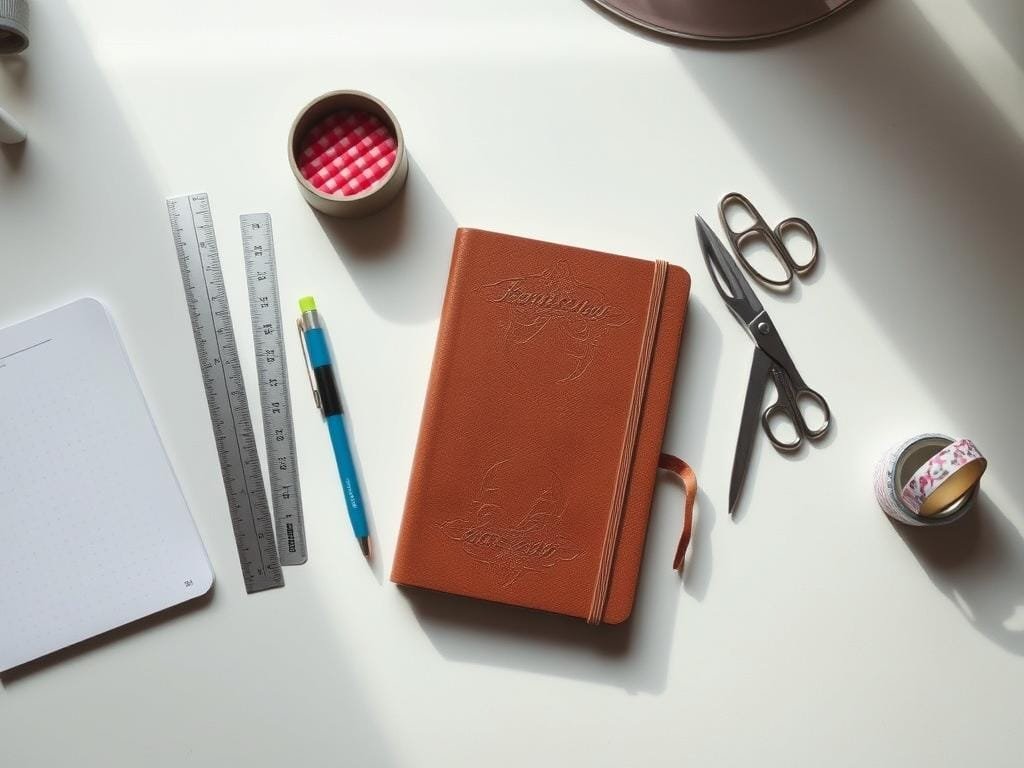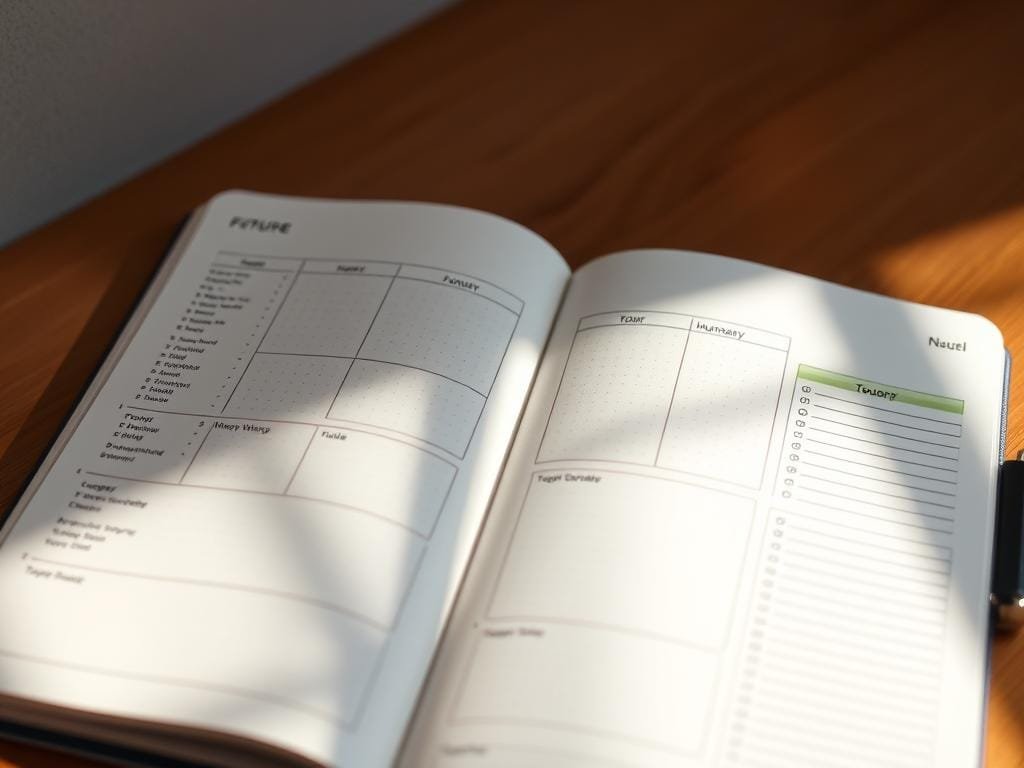Did you know the Bullet Journal method, created by Ryder Carroll in 2013, has become a global phenomenon? It has helped millions organize their lives and increase productivity. You can start your bullet journaling journey with just a blank notebook and a pen, making it accessible to anyone.
As you begin, you’ll see bullet journaling is more than a planner or diary. It’s a customizable system that fits your needs and lifestyle. By following simple steps, you can create a journal that helps you manage tasks, appointments, and goals. For a detailed guide, check out Brainbook: Bullet Journaling Your Way to a More Organized.
Table of Contents
Key Takeaways
- Start with a simple notebook and pen to begin your bullet journaling journey.
- Customize your journal to fit your needs and lifestyle.
- Use a key, index, and logs to organize your journal.
- Don’t be afraid to make mistakes and change layouts as needed.
- Keep an idea folder for inspiration and future reference.
What is Bullet Journaling?
The bullet journal method was created by Ryder Carroll. It’s a popular way to plan your life in a personal way. It’s not just for organizing tasks; it’s about making a system that fits you.
Definition and Origins
Bullet journaling is a customizable planning system that started in 2013. It’s flexible, letting you make a journal that meets your needs. Ryder Carroll, its creator, says it’s simple and adaptable.
The system has a few main parts. They help you keep track of tasks, appointments, and goals in one notebook.
Key Components of Bullet Journaling
So, what makes bullet journaling so effective? The key parts are:
- Index: A table of contents to help you find your way.
- Key: A legend that explains the symbols used in your journal.
- Future Log: A section for planning and tracking future events.
- Monthly and Daily Logs: Spreads for organizing tasks and appointments.
- Collections: Custom sections for tracking habits, moods, or other information.
These parts work together to make a comprehensive planning system that’s just for you. As you start using bullet journaling, you’ll see it boosts your productivity and organizes your life.
Getting Started with Your Bullet Journal
Starting your bullet journal journey is easy. It’s all about making it your own. You can change it to fit your life perfectly.
First, you need to make a few choices. These choices will help shape your journaling experience. Let’s look at what you need to think about.
Choosing the Right Journal
Choosing the right journal is key. You might like dotted, grid, or blank pages. It all depends on what you want to do in your journal.
- Dotted notebooks are great for bullet journaling because they’re flexible yet structured.
- Grid notebooks are good for making tables and charts.
- Blank notebooks let you be as creative as you want.
Think about the journal’s size, paper, and how it binds. A journal that stays flat is very helpful.

Essential Supplies You’ll Need
All you really need is a notebook and a pen. But, as you get better, you might want more things to make your journal better.
Here are some things you might want:
- A fine-tip pen for detailed work.
- Markers or colored pencils for color.
- Stickers or washi tape for fun touches.
- A ruler or straightedge for straight lines.
As you start, you’ll find what you like best. Then, you can add more things to your collection.
Start with the basics and be open to trying new things. This way, you’ll make a bullet journal that’s both useful and fun.
Setting Up Your Bullet Journal
To get the most out of your bullet journal, follow these steps to set it up effectively. Setting up your bullet journal is a key step to organize your life and boost your productivity.
Creating Your Index
The index is the heart of your bullet journal. It acts as a table of contents, making it easy to find different sections and pages. Start by dedicating a few pages at the beginning for your index. Update it as you add new sections or spreads.
Tips for creating an effective index:
- Leave some space for future additions.
- Use clear and concise descriptions for each entry.
- Update your index regularly to keep it current.
Designing Monthly Spreads
Monthly spreads are a key part of your bullet journal. They give you a snapshot of your schedule, tasks, and goals for the month. To design an effective monthly spread, consider including the following elements:
| Element | Description | Benefits |
|---|---|---|
| Calendar View | A visual representation of the month | Helps in planning and visualizing the month ahead |
| Task List | A list of tasks to be completed | Assists in prioritizing and managing tasks |
| Goal Setting | Space to outline monthly goals | Enhances focus on achieving specific objectives |
By incorporating these elements, you can create a monthly spread that keeps you organized and motivated. The benefits of journaling for beginners become clear as you see your productivity and organization grow over time.
Key Features of Bullet Journaling
To get the most out of your bullet journal, it’s key to know its main features. It’s designed to be flexible and fit your needs. This makes it great for staying organized and productive.
Future Logs
Future Logs give you a peek at the months ahead. You can write down important dates and plans. This helps you plan and avoid missing key events or deadlines.

Daily Logs
Daily Logs are for your daily tasks, appointments, and events. They help you keep up with your daily life and see how you’re doing. You can add journaling prompts for beginners to spark creativity and mindfulness.
Habit Trackers
Habit Trackers let you track your progress in good habits or breaking bad ones. They help you see patterns and areas to work on. Use journaling prompts for beginners in your Habit Trackers to stay motivated and focused.
| Feature | Description | Benefits |
|---|---|---|
| Future Logs | Overview of upcoming months | Plan ahead, track important dates |
| Daily Logs | Record of daily tasks and events | Stay on top of responsibilities, reflect on progress |
| Habit Trackers | Monitor progress in habits | Identify patterns, improve habits |
For more detailed guidance, check out The Lazy Genius Collective. They have great tutorials and inspiration for your bullet journaling journey.
Customizing Your Bullet Journal
Bullet journaling lets you make your journal your own. This makes it fun and useful for staying organized. As you keep using it, you’ll see how personalizing it can make a big difference.
Incorporating Goals and Dreams
Adding your goals and dreams to your journal is powerful. You can have special pages for your goals. Use goal-setting templates or a vision board to see your dreams come to life.
“The future belongs to those who believe in the beauty of their dreams.” – Eleanor Roosevelt. This quote shows why having a clear vision is key. By regularly checking and updating your goals, you stay on track.
Creative Layout Ideas
Trying new layouts keeps your journal exciting. You can play with typography styles, colors, and stickers and washi tape. A monthly theme can inspire your designs.
Doodles and Art Techniques
Adding doodles and art shows off your creativity. Simple doodles can decorate your pages. If you’re more skilled, complex art can make your journal stand out. Experiment with drawing tools and techniques to find what works for you.
- Use simple shapes and lines to create decorative elements.
- Experiment with different colored pens or markers.
- Incorporate inspirational quotes or lyrics.
Embracing bullet journaling’s customizability lets you create a journal that inspires you. It helps you stay organized and reach your goals while showing off your creativity.
Staying Motivated with Your Journal
As you keep journaling, it’s key to find ways to stay motivated. Journaling helps you track your progress and celebrate your wins, no matter how small.
To keep going, focus on tracking your progress and celebrating small victories. This way, you’ll see how far you’ve come and stay excited to keep journaling.
Tracking Progress
Tracking your progress is a big part of journaling. It lets you reflect on your experiences, note your achievements, and find areas to improve. Some great journaling techniques for beginners include:
- Creating a habit tracker to monitor your daily activities
- Using a future log to plan and anticipate upcoming events
- Maintaining a daily log to record your thoughts and experiences
By using these techniques, you can track your progress and stay motivated.

Celebrating Small Wins
Celebrating small wins is also key. It helps you keep up positive behaviors and motivates you to keep journaling. Some journaling ideas for beginners to celebrate small wins include:
- Writing down three things you’re grateful for each day
- Creating a “wins” page to record your accomplishments
- Reflecting on your progress and acknowledging your achievements
By celebrating your small wins, you’ll stay motivated and excited to keep journaling.
Common Mistakes to Avoid
Starting your bullet journaling journey? Be aware of common pitfalls. Bullet journaling is personal and can be tailored to your needs. But, some mistakes can make it less effective.
To get the most from your bullet journal, watch out for these common mistakes. For more insights, check out additional resources on journaling mistakes to avoid.
Overcomplicating Your Layout
One big mistake is making your layout too complicated. It’s tempting to add elaborate designs and many sections. But, this can cause clutter and make your journal hard to use. Keep it simple and focused on your main goals.
For beginners, journaling helps with organization and reduces stress. A simple and functional design can achieve this.
Comparing Your Journal to Others
Another mistake is comparing your journal to others. Bullet journaling is personal and creative. Comparing can lead to frustration and disappointment. Focus on your own needs and preferences instead.
When starting, remember the goal is to create a system that works for you. It’s not about competing with others.
Avoiding these mistakes lets you enjoy journaling’s benefits, like better productivity and a clearer mind. The key to successful bullet journaling is simplicity, functionality, and personal touch.
Using Bullet Journals for Productivity
Using a bullet journal can greatly improve your productivity. It helps you manage your time and organize tasks better. You can track your tasks, appointments, and goals in a way that suits you.
Time Management Techniques
Good time management is key to being more productive. In your bullet journal, you can use the Pomodoro Technique. This means working in 25-minute focused sessions, then taking a 5-minute break.
Another method is time blocking. It lets you schedule big chunks of time for important tasks. This helps you stay focused without distractions.
To better manage your time, try a daily log. It tracks how you spend your day. This helps you see where you can work more efficiently.
Setting Priorities Effectively
Setting priorities is vital for reaching your goals and being productive. In your bullet journal, you can use different ways to sort your tasks. The Eisenhower Matrix is a good tool for this.
- Urgent and important tasks should be your top priority.
- Important but not urgent tasks should be scheduled and planned for.
- Urgent but not important tasks can be delegated.
- Not urgent or important tasks should be eliminated or minimized.
By using the Eisenhower Matrix in your bullet journal, you focus on tasks that matter most. This boosts your productivity and helps you achieve your goals.
Integrating Other Planning Methods
Using your bullet journal with digital tools and other planners can make planning more effective. Mixing different methods can boost your productivity and organization. It’s all about finding what works best for you.
Combining with Digital Tools
Many find combining their bullet journal with digital tools very helpful. Digital calendars, reminder apps, and task management software add extra features. They make your journal even more useful.
You can use a digital calendar for appointments and events. Your bullet journal can handle tasks, goals, and daily thoughts. This mix offers the best of both worlds: digital ease and journaling’s touch.
| Digital Tool | Bullet Journal Component | Benefit |
|---|---|---|
| Digital Calendar | Monthly Spread | Enhanced scheduling and planning |
| Task Management App | Daily Log | Improved task tracking and reminders |
| Reminder App | Future Log | Better long-term planning and reminders |
Using Calendars and Planners Together
Using your bullet journal with other planners or calendars can also be good. For example, a wall calendar can track family schedules. Your bullet journal can focus on your tasks and goals.
Benefits of Combining Planners:
- Enhanced organization across different areas of your life
- Improved coordination with family members or colleagues
- Flexibility to choose the best tool for each task or event
By thoughtfully integrating different planning methods, you can create a system that is tailored to your needs and preferences, helping you stay organized and productive.
Community and Resources
To get the most out of your bullet journal, it’s key to explore online communities and resources. Connecting with other bullet journalists can offer new insights and keep you motivated. It also helps improve your journaling skills.
Online Forums and Social Media Groups
Online forums and social media groups for bullet journaling are very helpful. These places let you share your work, get feedback, and learn from others. You can find inspiration, ask questions, and join discussions on different journaling techniques.

Recommended Books and Blogs
There are also many books and blogs that can guide and inspire you. Experienced bullet journalists share their knowledge through blog posts, tutorials, and videos. You can find books that teach you various journaling techniques, from simple to complex.
Recommended resources include the official Bullet Journal website, blogs by experienced bullet journalists, and books on journaling and productivity. Using these resources helps you grow and keep up with new trends and techniques.
Tips for Sustaining Your Journaling Habit
Keeping a regular journaling routine is key to enjoying its benefits. To make journaling a habit, set aside a specific time and day for it. Make it a must-do part of your daily or weekly plan.
Making Journaling a Routine
Start with small, easy goals, like journaling for 10-15 minutes a day. As you get more comfortable, you can add more time. Being consistent is the secret to a lasting journaling habit.
Finding Inspiration for Your Journal
For new journaling ideas, check out Pinterest or Instagram. These platforms are full of inspiration from journaling communities. You can also find ideas in nature, art, or books. When starting, try different layouts and styles to keep your journal interesting.
By following these tips, you can keep your journaling habit alive and enjoyable. It will bring you joy and help you reach your goals.
